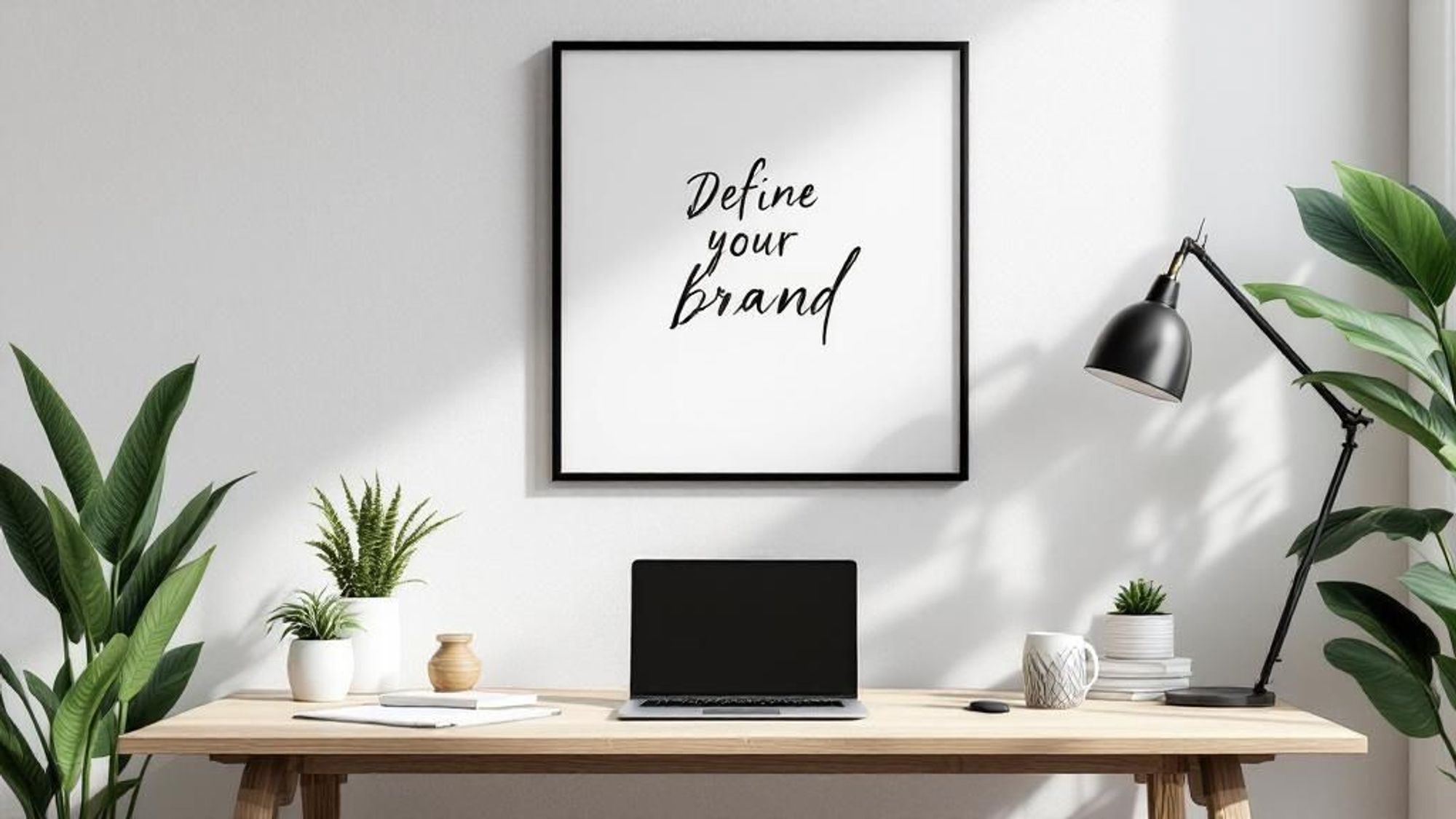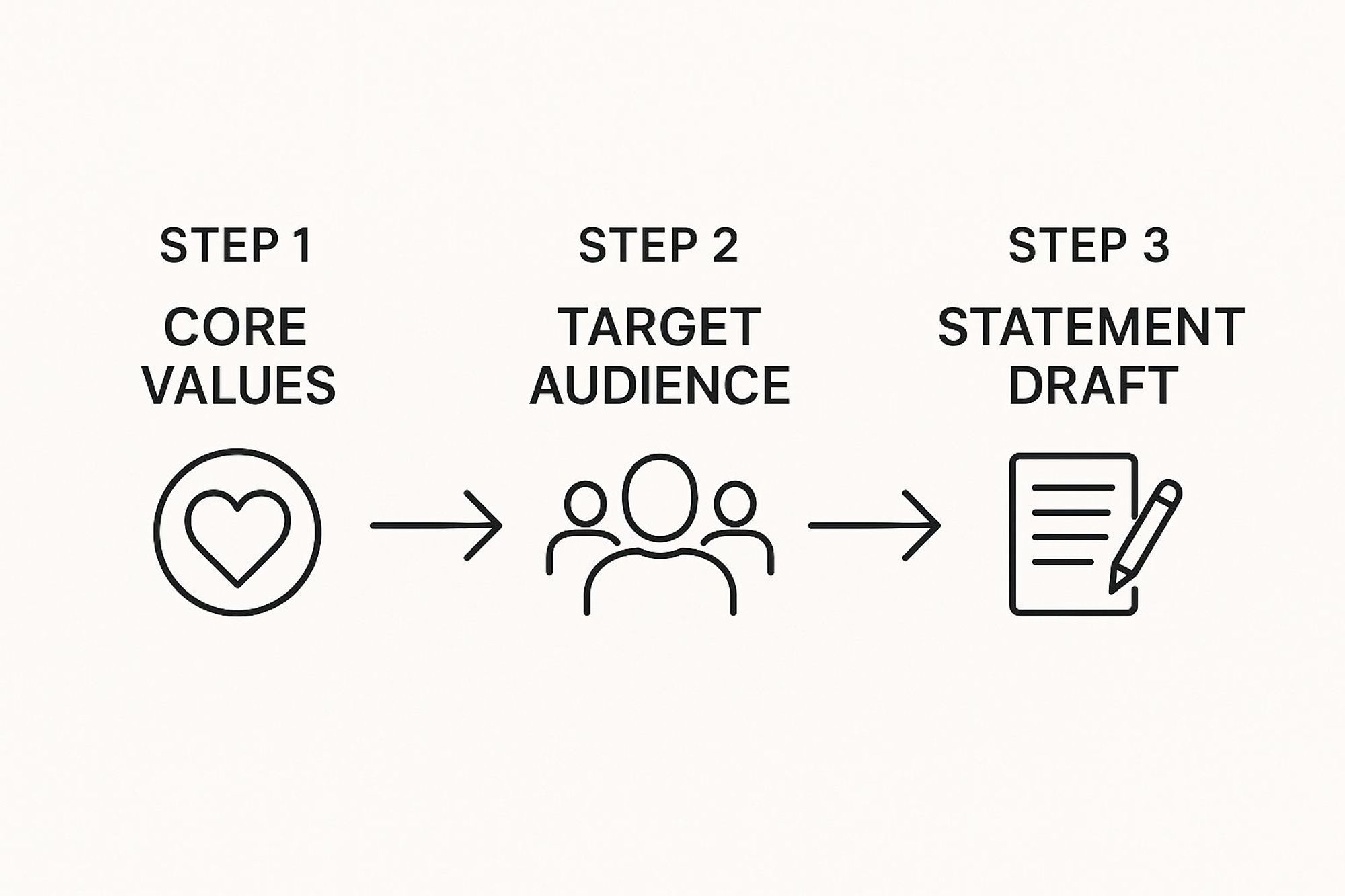Thursday, July 10, 2025
Crafting Your Personal Brand Statement (with Examples)


A personal brand statement is your professional tagline - a quick, memorable summary of who you are, what you do, and what makes you different. Think of it as the North Star for your career. It’s the core message that steers everything you do professionally and spells out the unique value you bring to the table.
Why Your Personal Brand Matters Now More Than Ever

In a world overflowing with talent, just having the right qualifications on paper isn't enough to get noticed. Your personal brand is your reputation in action. It's what people think of you, your skills, and the quality of your work before they've even had a conversation with you. It’s the story you’re telling without saying a word.
This isn't just another buzzword anymore. It's a non-negotiable part of growing your career, whether you're a fresh graduate hunting for your first job or a seasoned executive leading a team. So, why is personal branding important? Because in today's economy, trust is the real currency, and a strong, authentic brand builds it on a massive scale.
The Shift from Credentials to Credibility
We're in the middle of a huge shift in how people make professional decisions. Employers, clients, and partners no longer just glance at a resume and call it a day. They’re digging deeper, heading to digital platforms to get a real feel for your authenticity and expertise. Your online footprint is your living, breathing portfolio.
A killer brand answers some crucial questions for your audience right off the bat:
- What kinds of problems do you solve?
- What unique angle or perspective do you offer?
- Are you someone they can trust to deliver?
This is especially true on platforms like LinkedIn. A thoughtful approach to personal branding on LinkedIn can turn a static profile into a magnetic hub for new opportunities. It's often the first impression that decides whether you get a second look.
It's More Than Just a Logo or a Title
It's easy to get confused, but it's vital to understand the difference between a personal brand vs business brand. A business brand speaks for a company, but your personal brand is all about you. It's your unique promise, built on the foundation of your skills, your journey, and your personality.
And while cool visuals like personal brand logo examples can be a piece of the puzzle, they aren't the puzzle itself. Your brand has to be built on substance first. This is true whether you're looking at personal brand examples for students trying to land that first internship or personal brand examples for leaders who need to inspire and command respect.
A recent national research study drives this point home, showing that personal branding isn't a vanity project—it's a massive factor in how decisions get made. The study highlights that younger generations, especially, see a strong personal brand as a career necessity, not just a way to rack up likes. You can check out the full findings and see this shift for yourself on BrandBuildersGroup.com.
At the end of the day, putting real effort into your personal brand creates a powerful ripple effect. It gets your name out there through personal branding social media and, most importantly, puts you in the driver's seat of your own professional story. For a closer look at making your professional image work for you, explore these strategies to boost your personal brand. And if you want to see how this translates into real growth, check out our guide on how to get more social media followers.
Uncovering Your Authentic Brand DNA

Before you can write a single word of your personal brand statement, you have to get real about what you’re working with. Forget about inventing some slick persona. This is more like an archaeological dig than a performance. You’re simply uncovering the powerful, authentic story that’s already there.
This is what I call your Brand DNA.
It’s the one-of-a-kind mix of your core values, what you’re genuinely passionate about, the skills you’ve spent years honing, and your sense of purpose. Think of it as the common thread running through your entire career. Nailing this down is the first step to building a brand that actually feels like you—because it is.
To get there, we need to ask the right questions. This isn't just about what you do. It's about why you do it, and how you do it in a way nobody else can.
The Four Pillars Of Your Brand DNA
To really pin down your unique value, we need to look at four key areas. This self-discovery phase is the bedrock for everything else, from crafting your statement to figuring out where to even show up online.
- Your Values: What principles are completely non-negotiable for you? Maybe it’s unflinching integrity, constant innovation, or a deep sense of community. These are the guardrails for every professional choice you make.
- Your Passions: What gets you fired up? What problems do you find yourself trying to solve, even on a Saturday afternoon? Passion is the magnetic force that pulls people into your world.
- Your Skills: What are you genuinely great at? This includes both your technical skills (like financial modeling or coding) and your human skills (like negotiating or explaining complex ideas simply). This is the "how" behind your results.
- Your Purpose: What dent do you want to make in the universe? Who do you ultimately want to help? Your purpose is your brand’s North Star, giving it a clear direction and a mission worth following.
Getting this right ensures your brand rings true, whether you're a recent grad just starting out or a seasoned leader looking to make a bigger impact.
Your personal brand is not what you say it is. It's what your actions, your content, and your results consistently prove it to be over time.
From Self-Discovery To A Clear Position
Once you’ve got a handle on your Brand DNA, the next step is to give it some structure. To move from a jumble of ideas to a sharp, defined brand, using a solid brand strategy template to build a strong identity can be a game-changer. It helps you organize all that self-reflection into a clear market position.
This is the kind of foundational work that separates the amateurs from the pros. Understanding your DNA gives you the raw materials to confidently use tools like LinkedIn to create your personal brand, making sure your profile isn’t just a resume, but a true reflection of your value.
If you’re ready to see how this self-discovery translates into a real competitive edge, you’ll want to check out our guide on developing a brand positioning framework. This is how you stop sounding like a list of skills and start telling a powerful, focused story.
Crafting Your Personal Brand Statement: The Formula

Alright, you've done the hard work of digging into your Brand DNA. You've got all the raw materials—your values, your skills, your passions. Now, it's time to forge all that self-discovery into a sharp, memorable personal brand statement that does the talking for you.
We're moving from abstract ideas to a single, concrete sentence that nails your unique value. The goal here isn't to sound like a corporate robot or a motivational poster. It's to be crystal clear. A great statement is simple, direct, and leaves zero doubt about what you bring to the table.
This isn't about guesswork. We'll break it down into a simple, repeatable process. The key takeaway here is that you can't just jump to the final sentence. The foundational work—defining your audience and your core values—is what gives your statement its punch and authenticity.
The Proven Formula For A Powerful Statement
Let's get tactical. While there are a million ways you could phrase this, the most effective statements almost always have three core ingredients: who you help, what result you get for them, and how you do it differently. This framework strips away the fluff and gets straight to the point.
The most common—and effective—formula looks like this:
I help [Your Target Audience] achieve [A Specific, Desirable Result] by [Your Unique Method or Skill].
This structure forces you to be specific and value-driven. It completely reframes your introduction from "I am a..." to "I deliver...," which is way more compelling to anyone you meet, whether it's a potential client, employer, or collaborator. Getting this right is a critical part of knowing how to build a personal brand on LinkedIn or any other platform.
Breaking Down The Formula
Let's pull apart each piece of that template. Getting these components right is what makes your statement work everywhere, from your personal branding social media bios to your 30-second networking pitch.
- Your Target Audience: Who, specifically, are you here to serve? "Businesses" is way too broad. Think smaller. "Early-stage SaaS founders" is specific. It shows you understand a particular group's world and their problems.
- A Specific, Desirable Result: What’s the transformation you deliver? "Improve marketing" is vague and weak. "Generate qualified leads that double their sales pipeline" is a powerful, tangible outcome. Always focus on the benefit of what you do, not just the task itself.
- Your Unique Method or Skill: This is your secret sauce. It’s where your Brand DNA comes to life. It could be a proprietary process you’ve developed, a unique blend of skills you possess, or a specific technology you’ve mastered. This is what separates you from everyone else claiming to get a similar result.
To give you a head start, I've put together a few different templates you can play with. Depending on your career goals, one of these structures might feel like a better fit.
Personal Brand Statement Formulas
| Formula Type | Structure | Best For |
|---|---|---|
| The Classic | I help [Audience] achieve [Result] by [Unique Method]. | Consultants, freelancers, and service-based professionals. |
| The Mission-Driven | I am on a mission to [Big Goal] by [Your Contribution]. | Leaders, advocates, and those in impact-oriented roles. |
| The Skill-Focused | I combine [Skill A] and [Skill B] to create [Unique Outcome] for [Audience]. | Creatives, developers, and professionals with a unique skill set. |
| The Student/New Grad | I am passionate about using [My Skill] to help [Company Type] solve [Problem]. | Students and those early in their career showing potential and focus. |
Once you have a draft, say it out loud. Does it actually sound like something you would say? Is it memorable? This statement is the bedrock for your personal branding LinkedIn strategy, so it needs to feel authentic and be easy for you to share with confidence.
Real-World Personal Brand Statement Examples

It’s one thing to talk about formulas and templates. It’s another thing entirely to see them in action. Let's be honest, that’s when the lightbulb really goes on. A truly powerful personal brand statement is your north star, guiding how you build your presence online and even the kind of opportunities that come your way. Think of it as the core message that tells people exactly what you’re about, instantly.
Now, let’s get into some real personal brand examples for different stages of your career. As you read these personal branding examples, notice how they’re specific, packed with value, and feel authentic. They go way beyond a simple job title to make a clear promise about the results that person delivers.
Personal Brand Examples For Leaders
When you're an established pro, your statement needs to project authority, vision, and a track record of impact. These examples show how to blend experience with a forward-looking mission, making them fantastic personal brand examples for leaders.
- Example 1 (Tech Executive): "I build high-performing engineering teams that turn disruptive ideas into market-leading enterprise software."
- Why it works: This is so much more than "I manage engineers." It clearly defines her expertise (team building), her arena (enterprise software), and the incredible outcome she creates (market leadership). It’s confident, direct, and packed with value.
- Example 2 (Non-Profit Director): "I connect corporate partners with community initiatives to create sustainable social change and measurable impact."
- Why it works: This statement perfectly captures his unique role as a bridge-builder ("connects partners with initiatives"). It avoids vague jargon by focusing on the tangible result: "sustainable social change." You immediately understand his mission.
Personal Brand Examples For Students
If you're just starting out, your statement should shine a spotlight on your passion, skills, and potential. These personal brand examples for students are crafted to grab the attention of recruiters by showcasing ambition and a clear sense of direction.
- Example 1 (Marketing Student): "I use data-driven storytelling and Gen Z insights to help consumer brands build authentic connections on TikTok and Instagram."
- Why it works: It immediately demonstrates in-demand skills (data, specific social platforms) and a defined target audience (consumer brands). This shows value far beyond just being a student; it shows they're already thinking like a pro.
- Example 2 (Computer Science Student): "I am passionate about building intuitive and accessible mobile applications that solve everyday user frustrations."
- Why it works: This statement brilliantly combines a technical interest ("mobile applications") with a powerful, user-focused purpose ("solve everyday frustrations"). It shows empathy and a problem-solving mindset, which is gold to any tech company.
A great statement is the foundation for your personal branding linkedin strategy. It should be powerful enough to serve as your headline and concise enough to fit in your bio across all personal branding social media channels.
The focus on branding has exploded into a massive market. Businesses now spend an average of $1,000 each year on these services, fueling a global industry worth about $35 billion. That number alone shows just how crucial a polished brand has become. You can find more stats on the growth of the personal branding industry on FounderPal.ai.
And once you have your new statement, you need to use it consistently. For some hands-on help with that, check out our guide on social media content calendar ideas.
Bringing Your Brand to Life on LinkedIn and Social Media
A perfectly crafted personal brand statement has zero power if it’s just sitting in a notebook. To actually make a difference, you need to bring it online and transform it from a sentence into a living, breathing part of who you are online.
This is your playbook for turning that statement into a career-building machine.
The most important arena for this is, without a doubt, LinkedIn. Your statement is the perfect source material for figuring out how to build a personal brand on LinkedIn that pulls in opportunities instead of you having to chase them down. It’s not just about a one-time profile update; it's about weaving a consistent, compelling story across every single touchpoint.
A great place to start is by threading elements of your statement directly into your LinkedIn headline and "About" section.
Activating Your Brand on LinkedIn
Think of your LinkedIn profile as the digital first impression. It's often the first stop for recruiters, potential clients, and future collaborators. You have to make it count by putting your brand front and center.
- Your Headline: Ditch the generic job title. Seriously. Use a condensed, punchy version of your statement to immediately tell people your value. Instead of just "Marketing Manager," try something like, "Marketing Leader Driving B2B Growth Through Data-Driven Content Strategies." See the difference?
- Your About Section: This is where your full personal brand statement gets to shine. Use it as your opening hook, then spend the rest of the space backing it up with stories, proof, and evidence that you can deliver on your promise.
- Your Experience Section: Don't just list your old job duties like a resume. Frame your accomplishments using the language of your brand statement. Show how you delivered results that line up perfectly with your core value.
This is exactly how to use LinkedIn to create your personal brand in a way that feels authentic and powerful. For a deeper dive into optimizing every little piece of your profile, our detailed guide on your personal brand on LinkedIn is a must-read.
Your personal brand statement should become your content filter. Before you post, share, or comment on anything, ask yourself one simple question: "Does this reinforce the brand I want to build?" This keeps you consistent and builds a rock-solid professional identity over time.
Extending Your Brand Across Social Media
While LinkedIn is the professional heavyweight, consistent personal branding social media efforts on other platforms amplify your reach. The key is to adapt, not duplicate. Your core message—the "what" and "why" from your statement—stays the same, but you might need to tweak the delivery to match the platform's vibe.
The power of a strong online presence is hard to ignore. A staggering 89% of B2B professionals are on LinkedIn, making it an essential tool. And hiring managers are definitely watching. In fact, 98% of them research candidates online, and 47% admit they’re less likely to even interview someone they can't find.
Consistency is what builds trust and makes you recognizable. It’s the practical answer to the question of why is personal branding important—it makes you memorable. It makes you referable.
Whether you're a student showing off work on a portfolio site or a leader sharing insights on X (formerly Twitter), that core message has to be the same.
Ultimately, a sharp online brand makes networking more effective because it brings the right people straight to you. Just make sure that as you put yourself out there, you're following current LinkedIn etiquette guidelines to ensure every interaction is professional and makes the right impact.
Common Personal Branding Questions Answered
As you start pulling your brand together, you’re going to have questions. Everyone does. Let's tackle some of the most common sticking points with straightforward answers to keep you moving forward.
Personal Brand vs. Business Brand: What Is the Real Difference?
It’s actually simpler than it sounds. Think of it this way: a business brand is the reputation of a company. A personal brand vs business brand is the reputation of an individual. Apple is the business brand; Steve Jobs built a legendary personal brand.
Your personal brand is your unique promise of value, completely separate from wherever you work. It’s what makes you, you. This is a huge deal, whether we're talking about personal brand examples for leaders who are trying to build real influence or personal brand examples for students just trying to get a foot in the door.
How Do I Use My Statement on Social Media?
Your personal brand statement is the DNA of your personal branding social media strategy. It’s so much more than a bio. It should be the filter you run every single post, share, and comment through to make sure it all tracks back to your core message.
This is especially true for your personal branding LinkedIn game. When you learn how to build a personal brand on LinkedIn, you'll realize that statement is gold. You can break it down for your headline, expand on it in your "About" section, and even use its language to frame your work experience. It’s all about consistency.
A huge mistake I see people make is obsessing over visuals like personal brand logo examples before they've done the real work. Substance has to come before style. Your statement is the soul of your brand; a logo is just the face it wears. Get the message right first.
How Often Should I Update My Personal Brand Statement?
Your personal brand statement isn't a tattoo—it's not set in stone. It needs to grow and change right along with you. A good rule of thumb is to give it a look-over at least once a year or any time you hit a major career milestone.
These moments are the perfect trigger for a refresh:
- Changing careers or industries: Your audience and the value you bring them will probably shift.
- Gaining a major new skill: This could fundamentally change your unique method or the results you get for people.
- Shifting your long-term goals: As your ambitions evolve, your statement should evolve with them.
The goal is to make sure your statement always feels like an honest, accurate reflection of who you are professionally right now. Answering why is personal branding important begins with keeping your message current. As you use LinkedIn to create your personal brand, you’re building a living thing that needs a little tune-up now and then to stay sharp.
Finally, remember that a strong statement is your launchpad for creating content that connects. To put your brand into practice, you'll need to learn how to boost social media engagement and make sure your message actually gets heard.
No credit card required!